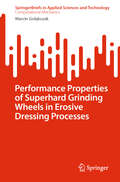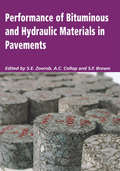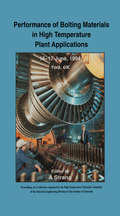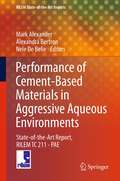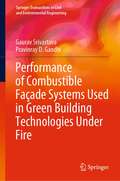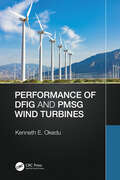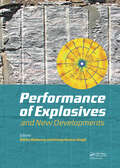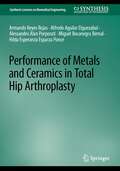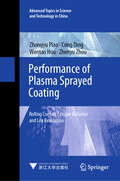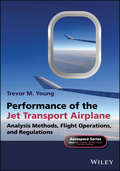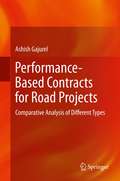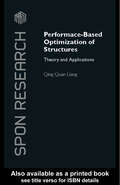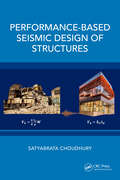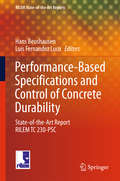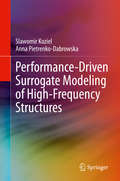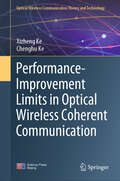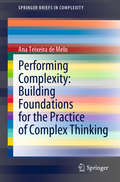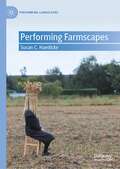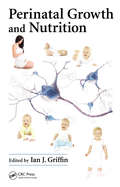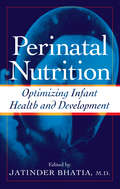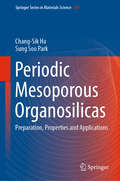- Table View
- List View
Performance Properties of Superhard Grinding Wheels in Erosive Dressing Processes (SpringerBriefs in Applied Sciences and Technology)
by Marcin GołąbczakThis book presents a scientific study covering all issues related to the development and assessment of the functional properties of superhard grinding wheels with a metal bond. Abrasive grinding, especially with superhard grinding wheels, is still the basic method for efficient and accurate shaping of workpieces, especially from materials with high hardness and durability. Meeting the high requirements placed on grinding processes, with regard to obtaining high dimensional-shape accuracy and the desired quality of the surface layer as well as repeatability of grinding results, requires the use of rational methods for shaping the cutting surface of grinding wheels (CSGW) in dressing processes. Individual chapters of the monograph include • Characteristics of superhard grinding wheels including properties of superhard abrasive materials, metal binders, construction, and marking of technical characteristics of grinding wheels and areas of their application, • Parameters and methods for assessing the performance properties of superhard grinding wheels, including direct and indirect assessment parameters and economic aspects of assessing the dressing of superhard grinding wheels, • Characteristics of dressing methods for superhard grinding wheels, including conventional methods and erosive dressing methods. The erosive dressing methods include dressing with a high-pressure stream of liquids, liquids and abrasives, laser dressing and electrochemical, electroerosive and hybrid methods. • Results of own research on electrochemical and electroerosion dressing processes, including mathematical modeling of these dressing processes and experimental research. The book meets the needs of both scientific and technical staff, providing knowledge about modern methods of shaping CPS of superhard grinding wheels. It will be an important reference in the libraries of technical universities as a research aid for students, technical staff, and research and teaching staff.
Performance of Bituminous and Hydraulic Materials in Pavements: Proceedings of the Fourth European Symposium, Bitmat4, Nottingham, UK, 11-12 April 2002
by S.E. Zoorob, A. C. Collop & S.F. BrownThis volume contains contributions from international experts, reflecting the rapid advances in the design of new improved bitumen and hydraulic bound composites, the trends in the use of waste and recycled materials and up-to-date methods of testing and evaluation.
Performance of Bolting Materials in High Temperature Plant Applications: Conference Proceedings, 16-17 June 1994, York, UK
by Andrew StrangThis book discusses the technology of high-temperature bolting materials and the design considerations of high-temperature bolted joints. It is based on the second international conference on high-temperature creep resistant materials held in York.
Performance of Cement-Based Materials in Aggressive Aqueous Environments
by Nele De Belie Mark Alexander Alexandra BertronConcrete and cement-based materials must operate in increasingly aggressive aqueous environments, which may be either natural or industrial. These materials may suffer degradation in which ion addition and/or ion exchange reactions occur, leading to a breakdown of the matrix microstructure and consequent weakening. Sometimes this degradation can be extremely rapid and serious such as in acidic environments, while in other cases degradation occurs over long periods. Consequences of material failure are usually severe - adversely affecting the health and well-being of human communities and disturbing ecological balances. There are also large direct costs of maintaining and replacing deteriorated infrastructure and indirect costs from loss of production during maintenance work, which place a great burden on society. The focus of this book is on addressing issues concerning performance of cement-based materials in aggressive aqueous environments , by way of this State-of-the-Art Report. The book represents the work of many well-known and respected authors who contributed chapters or parts of chapters. Four main themes were addressed: I. Nature and kinetics of degradation and deterioration mechanisms of cement-based materials in aggressive aqueous environments, II. Modelling of deterioration in such environments, III. Test methods to assess performance of cement-based materials in such environments, and which can be used to characterise and rate relative performance and inform long term predictions, IV. Engineering implications and consequences of deterioration in aggressive aqueous environments, and engineering approaches to the problem.
Performance of Combustible Façade Systems Used in Green Building Technologies Under Fire (Springer Transactions in Civil and Environmental Engineering)
by Gaurav Srivastava Pravinray D. GandhiThis book addresses fire safety of combustible façade systems which has gained much attention in recent times due to several major fire accidents across the world where combustible façade systems had a significant role in enhancing the growth of fire. The Grenfell tower (London) fire is one of the most severe accident in this category. The book covers basic design and functional aspects of commonly used façade systems along with the materials typically used in such systems. Subsequently, it discusses the currently available testing methods at component level, intermediate level, and system level. It also provides detailed case studies of six full-scale real fire façade fire experiments that have been jointly carried out by IIT Gandhinagar and Underwriters Laboratories at the full-scale façade testing facility established at IIT Gandhinagar. The book will enable designers and decision makers to make better assessments regarding fire safety of existing and upcoming façade systems. It also serves as a guide to deciding which testing methods are more appropriate under certain conditions.
Performance of DFIG and PMSG Wind Turbines
by Kenneth E OkeduDue to environmental pollution and climate change, the use of renewable energy sources as an alternative means of power generation is on the rise globally. This is because of their clean nature, which makes them ecofriendly with little or no pollution compared to the traditional fossil fuel power-generation power plants. Among the various renewable energy sources, wind energy is one of the most widely employed, due to its promising technology. Wind turbine technologies could be classified into two groups as follows: Fixed Speed Wind Turbines (FSWTs) and Variable Speed Wind Turbines (VSWTs). There have been tremendous improvements in wind turbine technology over the years, from FSWTs to VSWTs, as a result of fast innovations and advanced developments in power electronics. Thus, the VSWTs have better wind energy capture and conversion efficiencies, less acoustic noise and mechanical stress, and better power quality in power grids without support from external reactive power compensators due to the stochastic nature of wind energy. The two most widely employed VSWTs in wind farm development are the Doubly Fed Induction Generator (DFIG) and the Permanent Magnet Synchronous Generator (PMSG) wind turbines. In order to solve transient stability intricacies during power grid faults, this book proposes different control strategies for the DFIG and PMSG wind turbines.
Performance of Explosives and New Developments
by Vinay Kumar Singh Bibhu MohantyThere is considerable scope for improving the outcome of any blasting operation through basic understanding and application of the principles of blasting science and technology. The main objective of Performance of Explosives and New Developments is to sensitize the practitioner to critically examine the various empirical approaches in blasting whi
Performance of Metals and Ceramics in Total Hip Arthroplasty (Synthesis Lectures on Biomedical Engineering)
by Armando Reyes Rojas Alfredo Aguilar Elguezabal Alessandro Alan Porporati Miguel Bocanegra Bernal Hilda Esperanza Esparza PonceThis book offers expert guidance on materials for total hip arthroplasty (THA), providing readers with quick access to well-organized summaries on biomaterials such as metals, ceramics, polymers, and composites. It also includes in-depth coverage of biocompatibility and implant problems such as necrosis, ulceration, high toxicity with metals, and allergic reactions. Coverage also emphasizes the mechanical properties of the materials used for prostheses applications, immunity to corrosion, enhanced biocompatibility, complete inertness to the body environment, and the high capacity to join with the bone and other tissues. Performance of Metals and Ceramics in Total Hip Arthroplasty is an essential reference for engineers and scientists specializing in prostheses design and manufacturing and orthopedic medical professionals. The book can also be used as a study guide for materials science and orthopedics students.
Performance of Plasma Sprayed Coating: Rolling Contact Fatigue Behavior and Life Evaluation (Advanced Topics in Science and Technology in China #71)
by Zhenyu Zhou Zhongyu Piao Cong Ding Wentao HouThis book systematically summarizes the development process of thermal spraying technology, and elaborates on preparation, characterization, and testing methods of plasma spraying layers. Plasma spraying is a useful technology for remanufacturing. The life evaluation of remanufacturing product by using plasma spraying can be predigested to the life evaluation of surface plasma sprayed coating. This book also details the contact fatigue behavior of coatings, application of acoustic emission technology and rolling contact fatigue behavior of thermal sprayed coatings. This book will serve as a reference book for researchers in surface engineering, remanufacturing and other related fields.
Performance of the Jet Transport Airplane: Analysis Methods, Flight Operations, and Regulations
by Trevor M. YoungPerformance of the Jet Transport Airplane: Analysis Methods, Flight Operations, and Regulations presents a detailed and comprehensive treatment of performance analysis techniques for jet transport airplanes. Uniquely, the book describes key operational and regulatory procedures and constraints that directly impact the performance of commercial airliners. Topics include: rigid body dynamics; aerodynamic fundamentals; atmospheric models (including standard and non-standard atmospheres); height scales and altimetry; distance and speed measurement; lift and drag and associated mathematical models; jet engine performance (including thrust and specific fuel consumption models); takeoff and landing performance (with airfield and operational constraints); takeoff climb and obstacle clearance; level, climbing and descending flight (including accelerated climb/descent); cruise and range (including solutions by numerical integration); payload-ran≥ endurance and holding; maneuvering flight (including turning and pitching maneuvers); total energy concepts; trip fuel planning and estimation (including regulatory fuel reserves); en route operations and limitations (e. g. climb-speed schedules, cruise ceiling, ETOPS); cost considerations (e. g. cost index, energy cost, fuel tankering); weight, balance and trim; flight envelopes and limitations (including stall and buffet onset speeds, V-n diagrams); environmental considerations (viz. noise and emissions); aircraft systems and airplane performance (e. g. cabin pressurization and fuel); and performance-related regulatory requirements of the FAA (Federal Aviation Administration) and EASA (European Aviation Safety Agency). Key features: Describes methods for the analysis of the performance of jet transport airplanes during all phases of flight Presents both analytical (closed form) methods and numerical approaches Describes key FAA and EASA regulations that impact airplane performance Presents equations and examples in both SI (Syst#65533;me International) and British units Considers the influence of operational procedures and its impact on airplane performance Performance of the Jet Transport Airplane: Analysis Methods, Flight Operations, and Regulations provides a comprehensive treatment of the performance of modern jet transport airplanes in an operational context. It is a must-have reference for aerospace engineering students, applied researchers conducting performance-related studies, and flight operations engineers.
Performance-Based Contracts for Road Projects: Comparative Analysis of Different Types
by Ashish GajurelThis book focuses on the aspects of contracting contracts, basically related to road construction and management contracts. The book presents an analytical study of Performance-Based Road Management and Maintenance (PMMR), Funktionsbauvertrag (FBV) (Function-Based Construction Contract) and Public Private Partnerships (PPP). A separate chapter is also included about the comparative study of these contract types. The book provides useful material for university libraries, construction companies and government departments of construction.
Performance-Based Fire Engineering of Structures
by Yong Wang Martin Gillie Ian Burgess František WaldMajor events notably the Broadgate fire in London, New York‘s World Trade Center collapse, and the Windsor Tower fire in Madrid as well as the enlightening studies at the Cardington fire research project have given international prominence to performance-based structural fire engineering. As a result, structural fire engineering has increasingly at
Performance-Based Fire Safety Design
by Morgan J. Hurley Eric R. RosenbaumMaster an Approach Based on Fire Safety Goals, Fire Scenarios, and the Assessment of Design AlternativesPerformance-Based Fire Safety Design demonstrates how fire science can be used to solve fire protection problems in the built environment. It also provides an understanding of the performance-based design process, deterministic and risk-based ana
Performance-Based Optimization of Structures: Theory and Applications (Spon Research)
by Qing Quan LiangPerformance-Based Optimization of Structures introduces a method to bridge the gap between structural optimization theory and its practical application to structural engineering. The Performance-Based Optimization (PBO) method combines modern structural optimisation theory with performance based design concepts to produce a powerful technique for u
Performance-Based Seismic Design of Structures
by Satyabrata ChoudhurySeismic design of structures is fast turning to performance-based design (PBD) from old codal force-based design (FBD) method. The aim of the book is to expose readers to the meaning and need of PBD, the evolution of PBD to date, its various forms and applications. Various design philosophies and procedures have been described including modelling aspects and hazard considerations backed by examples. Direct displacement-based design (DDBD) and Unified PBD (UPBD) of reinforced concrete (RC) frame buildings, RC dual systems, steel frame buildings and bridge piers have also been explained.The main features of this book are as follows:• Illustrates performance-based seismic design to achieve the design target by performance objective-oriented design procedure. • Covers modern design philosophies, modelling aspects, concepts in nonlinearities and use of supplemental damping devices. • Contains a chapter on seismic safety of nonstructural components. • Describes UPBD design procedure and examples of different structural systems. • Includes application and examples with reference to SAP2000 software.This book is aimed at graduate students, researchers and professionals in civil engineering, earthquake engineering and structural design.
Performance-Based Specifications and Control of Concrete Durability
by Hans Beushausen Luis Fernandez LucoThis work gives an overview of significant research from recent years concerning performance-based design and quality control for concrete durability and its implementation. In engineering practice, performance approaches are often still used in combination with prescriptive requirements. This is largely because, for most durability test methods, sufficient practical experience still has to be gained before engineers and owners are prepared to fully rely on them. This book, compiled by RILEM TC 230-PSC, is intended to assist efforts to successfully build the foundation for the full implementation of performance-based approaches through the exchange of relevant knowledge and experience between researchers and practitioners worldwide.
Performance-Driven Surrogate Modeling of High-Frequency Structures
by Slawomir Koziel Anna Pietrenko-DabrowskaThis book discusses surrogate modeling of high-frequency structures including antenna and microwave components. The focus is on constrained or performance-driven surrogates. The presented techniques aim at addressing the limitations of conventional modeling methods, pertinent to the issues of dimensionality and parameter ranges that need to be covered by the surrogate to ensure its design utility. Within performance-driven methodologies, mitigation of these problems is achieved through appropriate confinement of the model domain, focused on the regions promising from the point of view of the relevant design objectives. This enables the construction of reliable surrogates at a fraction of cost required by conventional methods, and to accomplish the modeling tasks where other techniques routinely fail. The book provides a broad selection of specific frameworks, extensively illustrated using examples of real-world microwave and antenna structures along with numerous design examples. Furthermore, the book contains introductory material on data-driven and physics-based surrogates. The book will be useful for the readers working in the area of high-frequency electronics, including microwave engineering, antenna design, microwave photonics, magnetism, especially those that utilize electromagnetic (EM) simulation models in their daily routines.Covers performance-driven and constrained modeling methods, not available in other books to date;Discusses of a wide range of practical case studies including a variety of microwave and antenna structures;Includes design applications of the presented modeling frameworks, including single- and multi-objective parametric optimization.
Performance-Improvement Limits in Optical Wireless Coherent Communication (Optical Wireless Communication Theory and Technology)
by Xizheng Ke Chenghu KeThis book presents some of the recent developments in the field of optical-wireless coherence communication. The factors affecting the coherence detection sensitivity are analyzed and the approach to approximate the coherence detection limit is discussed. The wavefront distortion caused by atmospheric turbulence is analyzed, and the influence of the wavefront distortion on the coherence detection performance is examined. A new concept of vortex-beam coherence-detection is proposed, and the problem of signal light decomposition into partially coherent light detection is analyzed. This book can benefit researchers, engineers, and graduate students in the field of telecommunications. It is suitable for engineering and technical personnel engaged in applied optics and communications engineering, university teachers, graduate students, and senior undergraduates.
Performing Complexity: Building Foundations for the Practice of Complex Thinking (SpringerBriefs in Complexity)
by Ana Teixeira de MeloIn the face of growing challenges, we need modes of thinking that allow us to not only grasp complexity but also perform it. In this book, the author approaches complexity from the standpoint of a relational worldview. The author recasts complex thinking as a mode of coupling between an observer and the world. Further, she explores the process and outcome of that coupling, namely, meaningful information that may have transformative effects and impact the management of change in the ‘real world’. The author presents a new framework for operationalising complex thinking in a set of dimensions and properties through which it may be enacted. This framework may inform the development and coordination of new tools and strategies to support the practice and evaluation of complex thinking across a variety of domains. Intended for a wide interdisciplinary audience of academics, practitioners and policymakers alike, the book is an invitation to pursue inter- and transdisciplinary dialogues and collaborations.
Performing Farmscapes (Performing Landscapes)
by Susan C. HaedickeThis book argues that the performance-based work in the featured case studies contributes to the construction of food democracy where the public takes back decision-making in shaping the food system. It explores how contemporary artists translate scientific research about local and global agricultural issues into life stories that inform and engage their audiences and, in so doing, transform passive food consumers into proactive food citizens. The pairing of performing and farmscapes (complex webs of farmlands and storylines) enables artists to use embodied practices to encourage audiences to imagine a just and sustainable agri-food system and to collaborate on making it a reality. The book arranges the case studies on a trajectory that moves from projects that foreground knowledge acquisition to ones that emphasize social engagement by creating conversations and coalitions between farming and nonfarming communities to a final one that pairs protest art and political activism to achieve legally-binding changes in the agricultural landscape.
Perfusion Cell Culture Processes for Biopharmaceuticals: Process Development, Design, and Scale-up (Cambridge Series in Chemical Engineering)
by Massimo Morbidelli Moritz Wolf Jean-Marc BielserMaster the design and operation of perfusion cell cultures with this authoritative reference. Discover the current state-of-the-art in the design and operation of continuous bioreactors, with emphasis on mammalian cell cultures for producing therapeutic proteins. Topics include the current market for recombinant therapeutic proteins, current industry challenges and the potential contribution of continuous manufacturing. Provides coverage of every step of process development and reactor operation, including small scale screening to lab-scale and scale-up to manufacturing scale. Illustrated through real-life case studies, this is a perfect resource for groups active in the cell culture field, as well as graduate students in areas such as chemical engineering, biotechnology, chemistry and biology, and to those in the pharmaceutical industry, particularly biopharma, biotechnology and food or agro industry.
Perinatal Growth and Nutrition
by Ian J. GriffinPreterm infants grow poorly after birth and very commonly develop ex utero growth restriction (EUGR). However, the risks and benefits of catch-up growth in preterm infants must be weighed, and evidence addressing this warrants examination. Perinatal Growth and Nutrition explores the reasons for EUGR and the long-term effects on developmental outcom
Perinatal Nutrition: Optimizing Infant Health & Development (Nutrition And Disease Prevention Ser. #Vol. 2)
by Jatinder BhatiaPerinatal Nutrition describes the role of nutrition in newborn growth and development, the reduction of health risks, and the prevention of morbidity in the neonatal period and infancy. This important reference presents valuable nutritional strategies for the care of perinatal patients from preconception through infancy and after hospital release,
Periodic Mesoporous Organosilicas: Preparation, Properties and Applications (Springer Series in Materials Science #281)
by Chang-Sik Ha Sung Soo ParkThis book provides a comprehensive overview of the fundamental properties, preparation routes and applications of a novel class of organic–inorganic nanocomposites known as periodic mesoporous organosilicas (PMOs).Mesoporous silicas are amorphous inorganic materials which have silicon and oxygen atoms in their framework with pore size ranging from 2 to 50 nm. They can be synthesized from surfactants as templates for the polycondensation of various silicon sources such as tetraalkoxysilane. In general, mesoporous silica materials possess high surface areas, tunable pore diameters, high pore volumes and well uniformly organized porosity. The stable chemical property and the variable ability for chemical modification makes them ideal for many applications such as drug carrier, sensor, separation, catalyst, and adsorbent. Among such mesoporous silicas, in 1999, three groups in Canada, Germany, and Japan independently developed a novel class of organic–inorganic nanocomposites known as periodic mesoporous organosilicas (PMOs). The organic functional groups in the frameworks of these solids allow tuning of their surface properties and modification of the bulk properties of the material.The book discusses the properties of PMOs, their preparation, different functionalities and morphology, before going on to applications in fields such as catalysis, drug delivery, sensing, optics, electronic devices, environmental applications (gas sensing and gas adsorption), biomolecule adsorption and chromatography. The book provides fundamental understanding of PMOs and their advanced applications for general materials chemists and is an excellent guide to these promising novel materials for graduate students majoring in chemical engineering, chemistry, polymer science and materials science and engineering.
Periodic Motions to Chaos in a Spring-Pendulum System (Synthesis Lectures on Mechanical Engineering)
by Albert C. Luo Yu GuoThis book builds on the fundamental understandings, learned in undergraduate engineering and physics in principles of dynamics and control of mechanical systems. The design of real-world mechanical systems and devices becomes far more complex than the spring-pendulum system to which most engineers have been exposed. The authors provide one of the simplest models of nonlinear dynamical systems for learning complex nonlinear dynamical systems. The book addresses the complex challenges of the necessary modeling for the design of machines. The book addresses the methods to create a mechanical system with stable and unstable motions in environments influenced by an array of motion complexity including varied excitation frequencies ranging from periodic motions to chaos. Periodic motions to chaos, in a periodically forced nonlinear spring pendulum system, are presented through the discrete mapping method, and the corresponding stability and bifurcations of periodic motions on the bifurcation trees are presented. Developed semi-analytical solutions of periodical motions to chaos help the reader to understand complex nonlinear dynamical behaviors in nonlinear dynamical systems. Especially, one can use unstable motions rather than stable motions only.
